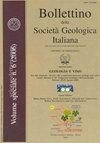The first observations of CO2 and CO2/SO2 degassing variations recorded at Mt. Etna during the 2018 eruptions followed by three strong earthquakes
引用次数: 8
Abstract
Mount Etna volcano is well-known for its frequent eruptions and high degassing rates from its summit craters and flanks. The geochemical monitoring network on Mt. Etna that measures soil CO2 flux and in-plume CO2/SO2 ratio recorded very important degassing variations from the flank and the summit craters during the second half of 2018. In this area several significant volcanic events occurred in October and December 2018 and in January 2019. Past observations have distinguished a tendency for wide variations in degassing rates, marked by a sharp increase preceding the onset of volcanic activity. However, this is the first time that three earthquakes of magnitude M>4 have been registered since the inception of the geochemical network in January 2001. Of particular interest is the CO2/SO2 ratio in plumes recorded by the monitoring station sited at the summit crater of Voragine showed very significant degassing variations, which were comparable with those recorded for the soil CO2 flux.This paper focuses on the combination of events occurring on Mt. Etna and their relationship with degassing rates. The most remarkable results can be summarized as follow: i) the networks recorded high variations of soil CO2 flux and CO2/SO2 ratio, which assisted in identifying distinctive phases of pressurization of Mt. Etna plumbing system and ii) all earthquakes occurred during phases of minimum gas rate, which in turn followed stages of pressurization involving different portions of the plumbing system. The 2018 period of high volcanic activity and the corresponding seismic episodes provided an invaluable case study for Mt. Etna, which allowed to combine seismic events and geochemical signal variations.2018年埃特纳火山爆发期间,首次观测到二氧化碳和二氧化碳/二氧化硫脱气变化,随后发生了三次强烈地震
埃特纳火山以其频繁的喷发和其顶部火山口和侧翼的高排气率而闻名。埃特纳火山的地球化学监测网络测量了土壤二氧化碳通量和烟羽内二氧化碳/二氧化硫比,记录了2018年下半年火山侧面和山顶陨石坑非常重要的脱气变化。2018年10月和12月以及2019年1月,该地区发生了几次重大火山事件。过去的观察发现,在火山活动开始之前,脱气率有大幅度变化的趋势,其特征是急剧增加。然而,这是自2001年1月地球化学台网建立以来首次记录到3次4级地震。特别令人感兴趣的是,位于Voragine山顶火山口的监测站记录的羽流中CO2/SO2的比率显示出非常显著的脱气变化,这与土壤CO2通量的记录相当。本文重点研究了埃特纳火山上发生的一系列事件及其与脱气速率的关系。最显著的结果可以概括如下:1)网络记录了土壤CO2通量和CO2/SO2比的高变化,这有助于识别埃特纳火山管道系统的不同增压阶段;2)所有地震都发生在最小气体速率阶段,而这又伴随着管道系统不同部分的增压阶段。2018年的高火山活动期和相应的地震事件为埃特纳火山提供了宝贵的研究案例,可以将地震事件和地球化学信号变化结合起来。
本文章由计算机程序翻译,如有差异,请以英文原文为准。
求助全文
约1分钟内获得全文
求助全文

 求助内容:
求助内容: 应助结果提醒方式:
应助结果提醒方式:


